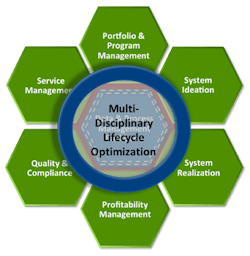Are You Prepared for the Heap of Capital Investments Coming?
Industrial impacts of the new U.S. federal tax laws are already emerging. A big impact is coming from accelerated—depreciation provisions—the expensing of capital equipment investments as one-year write-offs throughout the U.S. economy. New capabilities for product development can be now be expensed rather than depreciated over a period of years, which generates significant tax savings.
Also promising a big impact is the accumulated offshore corporate profits now being repatriated. Apple Computer’s pending $38 billion payment to the U.S. Treasury, though eye-popping, may be only a small part of the cash hoards headed back to the U.S. Apple has about $252 billion overseas, Microsoft $137 billion, Cisco Systems $70 billion, and Alphabet/Google $64 billion. This adds up to just over half a trillion dollars, a sizeable portion of which will be invested in capital improvements. Goldman Sachs' more conservative estimate is $250 billion. Either way, it's a lot.
And the history of big tax cuts virtually guarantees a surge in demand for capital goods and industrial products. Both producers and users will seize the day. Virtually guaranteed are three challenges:
A demand surge: The Association for Manufacturing Technology, for example, predicts that 2018 orders for manufacturing equipment will rise 12%. Can today’s product development strategies and their processes meet that demand? The best companies, of course, always manage to do more with less, but processes and technologies still need to improve if the demand is to be met.
Industrial equipment companies are, of course, hard at work on tomorrow’s new products. But do the designers and engineers have the tools they need?
A labor scarcity: Economists have been telling us for some time that employment and unemployment data mean just about everyone who can hold a job has one. Add to that the Baby Boomer retirement wave and U.S. factories struggle to fill tens of thousands of skilled jobs, knowledge management, and automation’s bottom line appeal increases.
A technology tsunami: Digitalization capabilities are surging, which presents another challenge to updating product development. Planners must be familiar with Digital Twins / Digital Threads, additive manufacturing (3D printing), augmented / virtual reality, generative design, and the Internet of Things (IoT) with all of its security question marks and leavened with artificial intelligence and machine learning.
All can be useful, but which will generate the needed improvements in the short term while enabling long-term success and sustainability? Most companies use some of these capabilities but very few use all of them: Which ones will the enterprise need in for the next few years? CIMdata thinks these challenges dictate that every industrial company re-examine how their product life cycle is approached. What has worked for many years may soon may not.
Given the recent tax changes and foreseeable disruptions, what is to be done with tool sets and processes that can leverage the opportunity? Enhance and Extend (E&E) provides a near-term approach promising fast, tangible gains and maximizes the capabilities of what is already in place to meet the upcoming demand.
If E&E is too little too late, the alternative is Rip and Replace (R&R), preferably in phases rather than a Big Bang. Either way, tuning up product development will quickly optimize business operations and catalyze new revenue streams. Tools for design, modeling, analysis, optimization, production, and maintenance will be pulled more tightly together.
New product development capabilities have to be assembled piece by piece, building on existing toolsets, workflows, technologies, and skill sets, then connecting them in new ways, adapting to changing needs.
For more detail, please click HERE.
This is where honesty and candor enter the story. We are not talking here abut honesty and candor in calculating big new corporate tax breaks. Instead, we are assessing and analyzing the opportunities presented by these tax breaks ... and the product development challenges uncovered by them.
These assessments and analyses deal with several questions:
- What still works? Which engineering assets—toolsets and processes—to meet deadlines and requirements with minimal complaints and few if any work-arounds. Indicators of trouble include an inability to cost-effectively update or modify the solutions; difficulty in enabling needed new processes; difficulty in finding data needed in decision making plus software instability and too many spreadsheets.
- And “still works” for how much longer? Not so easy; this is an assessment of foreseeable disruptions and to handle them. In other words, how innovative is the status quo? For pinpointing workflow snags and process shortfalls that are most likely to impact product development, honesty and candor are indispensable.
Every industrial equipment company already has some form of a Product Innovation Platform. After all, without one there would be no product development and, soon, no revenue. The issue is determining—honestly and candidly—whether the status quo is innovative enough.
Whether the end product of E&E or R&R, Product Innovation Platforms are made up of countless “moving parts,” each one quite complex and some changing abruptly. Moreover, there is no one size fits all. Labels like “disruption” and “dynamic” do not convey the everyday, on the ground reality of product development. A Product Innovation Platform is about as far as one can get from shrink-wrapped, commercially available, off-the-shelf software, a.k.a. COTS.
The takeaway is to build an E&E road map to assess foreseeable demands. For the longer term, carefully weigh R&R. We cannot recommend that equipment manufacturers single-handedly try to turn a product development status quo (even a good one) into a Product Innovation Platform.
Tom Gill is Practice Manager and Fred Keith is Senior Business Development Manager, Industrial, in CIMdata’s PLM Enterprise Value & Integration practice (PEVI). CIMdata is a strategic management consulting firm focused on PLM.
About the Author
Tom Gill and Fred Keith
Tom Gill is Practice Manager and Fred Keith is Senior Business Development Manager, Industrial, in CIMdata’s PLM Enterprise Value & Integration practice (PEVI). CIMdata is a strategic management consulting firm focused on PLM.


